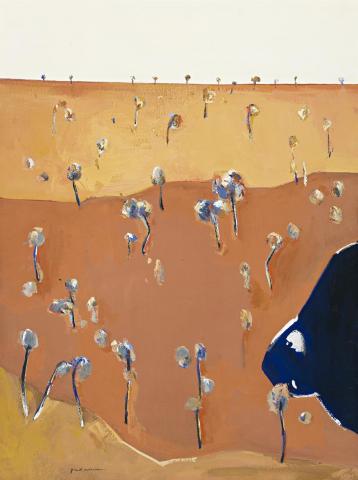WATERPOND IN A LANDSCAPE, c.1966
FRED WILLIAMS
gouache on paper
75.5 x 56.5 cm
signed lower left: Fred Williams
Rudy Komon Gallery, Sydney
Mungo McCallum, Sydney
Private collection, Melbourne
Deutscher~Menzies, Sydney, 7 December 2005, lot 49
Private collection, Brisbane
Waterpond in a Landscape II and III, 1966, oil on canvas, 152.5 x 122.0 cm, private collections, in McCaughey, P., Fred Williams, Bay Books, Sydney, 1980, pp. 175–176 (illus.)
The gouache Waterpond in Landscape 1966 is among Fred Williams's finest watercolours. The first thing to catch the eye is its striking colour drama combined with an engaging feeling of immediacy. Add to that the interplay between flatness and ever-subtle illusion, together with the sensuous milky textures of the rich pigments, and you have a feast of visual delight. Figuratively based on the water pond at Lysterfield, it is majestically redolent of the sun-baked Australian landscape and its related atmosphere. Bold areas of colour, gradations, and detailed features nevertheless conjure up all the complexities and fascination of a non-figurative work. In this brilliant fusion of reality and abstraction, Williams characteristically presents views in profile and plan, as gum trees sport across fields of ochre. Surfaces are further enlivened by the textured colours and contrasting blues of the gums, all intruded upon by the dark depths of the pond. The movement both into and across the picture surface is held in perfect balance. Although the rising plane of the landscape leads the eye high into the distant horizon, the ascending bands of colour emphasize its flatness, which in turn is married to that of the picture plane. Irregular contours and dancing eucalyptus trees add further lively interest.
Following on the great Upwey series of landscapes paintings of 1965-66, this was a particularly fruitful period in Williams's art. The new theme of the water pond in the landscape, worked in both oils and gouache in early 1966, was realised with a new informality, variety and invention. In his monograph on Williams, Patrick McCaughey notes that in three oils on the subject 'Williams's art becomes increasingly radical. The progression from Water Pond [sic] in Landscape I to III is one of increasing flatness and abstractness, allied to increasing brilliance and luminosity of colour.'1 As an acknowledgement of their outstanding quality, two of these three large landscapes were held in such prestigious collections as Rudy Komon and James Fairfax. While a greater immediacy can be found within the formally structured oils, it is even more so for our gouache because of the more fluid nature of its medium. Abandoning the artifice of Western perspective, Williams's landscapes have a closer affinity with Chinese art in the exploration and exposition of the breadth and intimacy of the Australian scene, transcending mere verisimilitude. As James Gleeson wrote in his review of Williams's exhibition at the Rudy Komon Gallery in 1966, 'Williams has made the wooded hills and plains of Victoria his special province, and so persuasive are his images that we cannot look at the real thing except in the terms he has set down for us in paint.'2 It is an ongoing testimony to the originality of his vision.
1. McCaughey, p., Fred Williams, Bay Books, Sydney, 1980, p. 174
2. Gleeson, J., 'Williams is at his best', Sun, Sydney, 12 October 1966
DAVID THOMAS
